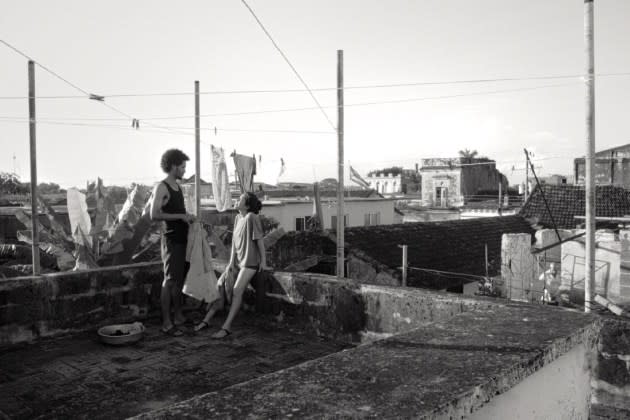‘Oceans Are the Real Continents’ Review: A Poetic Chronicle of Cubans Trapped Between Home and Exile

Director Tommaso Santambrogio’s beautifully realized first feature, Oceans Are the Real Continents (Los Océanos Son Los Verdaderos Continentes), presents a number of intriguing paradoxes: It’s both grounded in realism and highly stylized, like a social documentary shot by a first-class photographer. It’s a stark portrait of Cubans deeply impacted by exile, but one that was made by a foreigner (Santambrogio is Italian). And it’s a film about the quiet desperation of a place many people are struggling to leave — although it makes Cuba look much more like a country you want to visit rather than escape from.
A previous example of this kind of filmmaking — and one that feels like a major influence on Oceans — is Russian auteur Mikhail Kalatozov’s 1964 feature I Am Cuba, a gorgeous and monumental study of the island that was shot several years after the revolution (and only released worldwide in the early 1990s, thanks to the help of directors like Martin Scorsese).
More from The Hollywood Reporter
Both works are high-art movies portraying Cuba as a poetic world onto itself, and one that faces constant threats from the outside. In Kalatozov’s film, which chronicles the period just before Castro seized power, wealthy foreigners exploit the locals both in Havana and on rural sugar plantations, provoking a popular revolt. In Santambrogio’s contemporary tale, Cubans are lured away by the possibility of a better life abroad, abandoning their loved ones — and their beloved homeland — out of necessity.
When Oceans begins, it’s actually hard to tell if the film is taking place today or back in the early 1960s, when I Am Cuba was made. Such is another paradox of this richly made, minimalist drama: In terms of economic development, the Cuba depicted is still stuck in the revolutionary days, with crumbling public buildilngs, old cars and very little in terms of modernity. But that’s what also renders it so attractive: Man seems much closer to nature in a place where nobody uses a cell phone or stares at a screen, making us long for a time when that was still possible.
Set in San Antonio de los Baños, a small city about an hour’s drive from Havana, the film hops between three stories of exile that stretch across three generations. In the first and main narrative, a couple in their 20s — puppeteer Edith (Edith Ybarra Clara) and drama teacher Alex (Alexandre Diego) — find their relationship severely tested when the former obtains a visa to go work in Europe, where she plans to stay and start a new life.
The pair seems made for each other: They love the same theater, poetry and literature (especially Italian writer Giuseppe di Lampedusa), and spend their time wandering around the empty streets and surrounding tropical forests of their bucolic hometown. But this clearly isn’t enough for Edith, who’s already applied for papers to go overseas, while Alex seems fully invested in the drama school where he teaches children.
Neither actor has performed in a movie before, and the same goes for the rest of the cast, whom Santambrogio recruited while preparing the shoot. This includes Milagros Llanez Martínez, portraying an older woman revisiting the letters her late husband mailed home three decades earlier; and the young boys Frank Ernesto Lam and Alain Alain Alfonso González, playing two friends on the same little league baseball team.
Like Alex and Edith, these other characters find their lives upended by pressures from the outside world: In the case of Milagros, we learn that her husband participated in the deadly Angolan Civil War back in the late 1980s, joining Cuban troops who fought against the South Africa-backed anti-communists. For the two boys, who dream of playing for the New York Yankees, we overhear Frank’s mother talking about moving to Miami to join the rest of her family, which would oblige Frank to leave his best friend behind.
Nobody in Oceans stands on steady ground, and despite the peaceful ambiance of the town and the staid nature of the drama, life is a constant push-and-pull between the here and there — between the place you’re stuck in and the one that keeps luring you away. Exile seems like the only possible solution for so many stilted lives — an opening radio broadcast explains that a record number of Cubans have been moving abroad — and what lies across the ocean doesn’t necessarily seem better, but inevitable.
Santambrogio, who shot the film with cinematographer Lorenzo Casadio Vannucci, takes great pains to render all the real locations in exquisite black-and-white detail, amplifying the visual splendor in which the stories unfold. Whether we’re inside the theatre where Edith puts on a touchingly symbolic marionette show toward the end of the movie, or on the baseball field where Frank and Alain practice pitching and hitting, the country is a magical place despite all the poverty and hopelessness.
Which brings us to the final paradox in Oceans, and one that ultimately winds up driving some people abroad while others choose to indefinitely stay: Cuba can be both extremely sad and extremely beautiful at the same time.
Best of The Hollywood Reporter

 Yahoo News
Yahoo News 